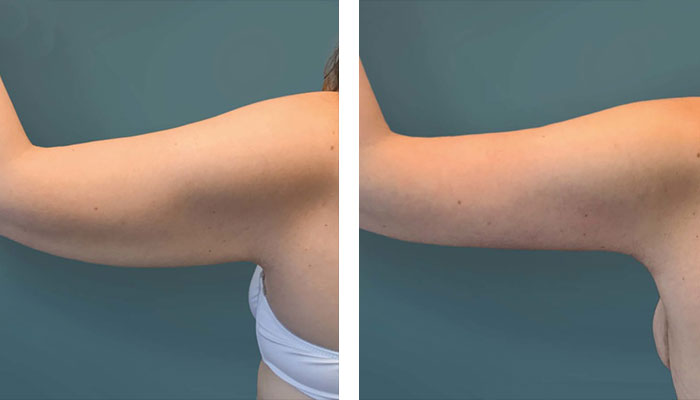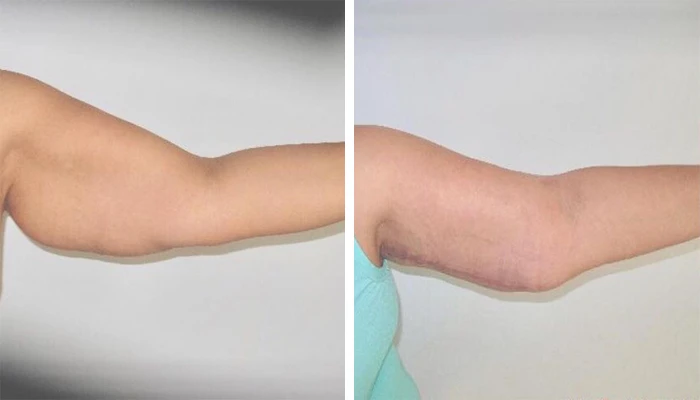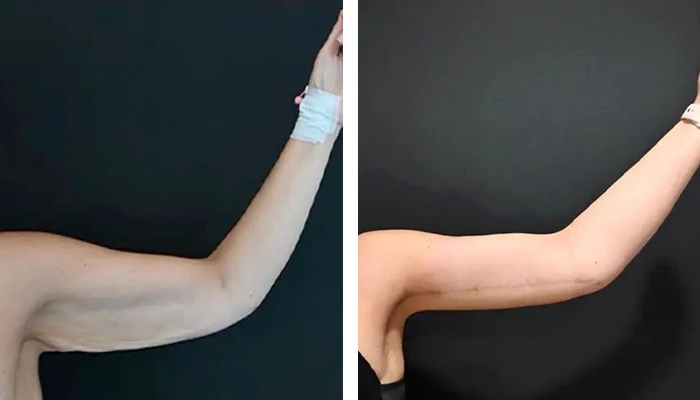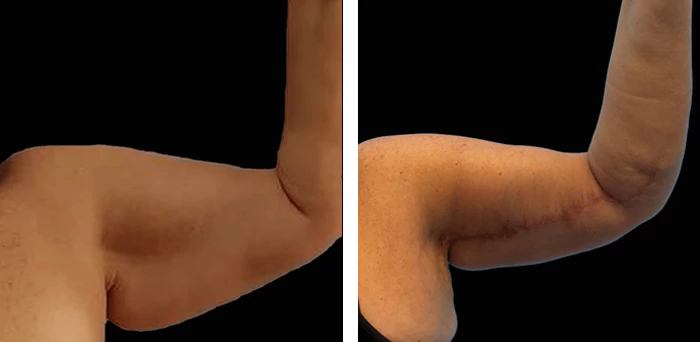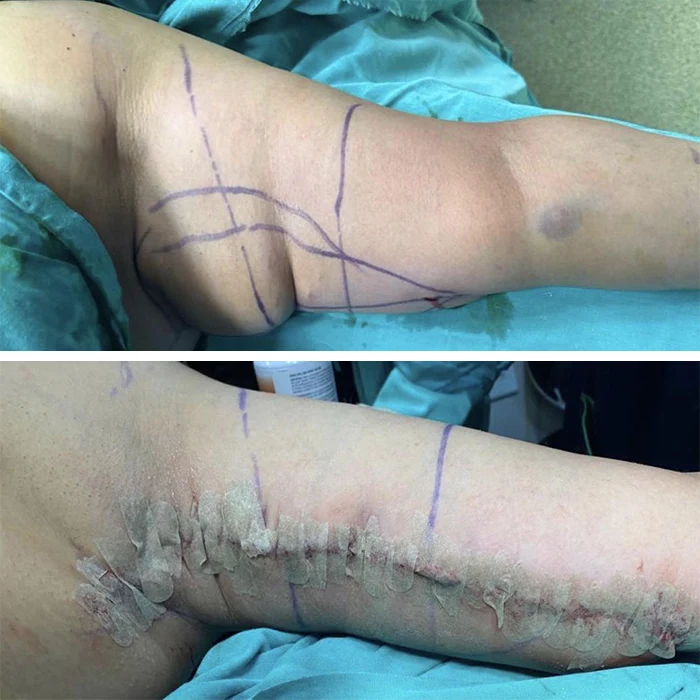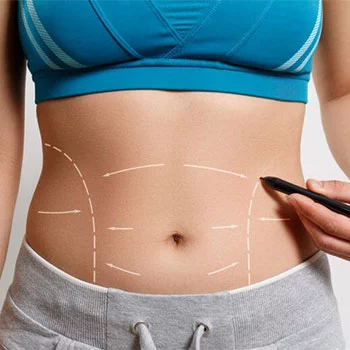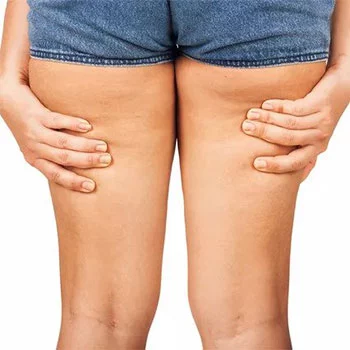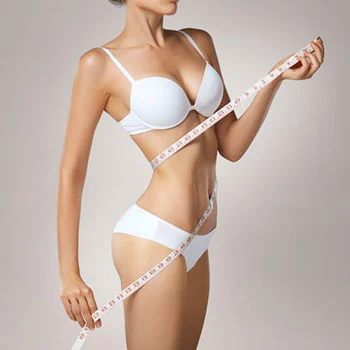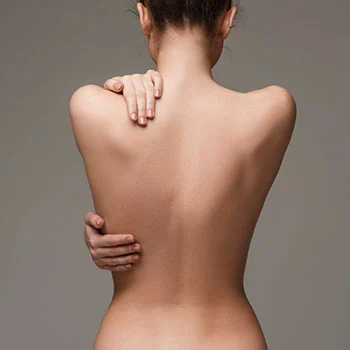What is an arm lift?
An arm lift, also known as brachioplasty, is a surgical procedure aimed at reshaping the upper arms by removing excess skin and fat. This procedure is typically sought by individuals who have experienced significant weight loss or aging, resulting in loose, sagging skin on the arms. During an arm lift, the excess skin is trimmed, and the underlying tissues may be tightened to create a more toned and contoured appearance. Arm lift surgery can help improve arm aesthetics, restore self-confidence, and enhance the overall arm contour.
Why is an arm lift needed?
An arm lift is sought by people with flabby arms. Flabby arms or "bat wings" refer to the condition where the skin on the upper arms becomes loose and hangs down, resembling the wings of a bat when the arms are extended. This aesthetic concern is often due to factors such as aging, genetics, significant weight loss, or loss of skin elasticity.
Flabby arms can affect one's self-confidence and make it challenging to wear certain clothing styles. An arm lift surgery is commonly performed to address sagging arms and achieve a more toned and contoured arm appearance. In general, an arm lift may be done for the following reasons:
- Excess skin: Significant weight loss or aging can lead to excess, loose skin on the upper arms, which may not respond to diet and exercise.
- Sagging skin: Skin laxity in the upper arms can result in a "bat wing" appearance, causing self-consciousness and discomfort.
- Improved arm contour: An arm lift can help reshape and contour the arms, creating a more toned and defined look.
- Boost in confidence: For individuals who feel self-conscious about the appearance of their arms, an arm lift can improve self-esteem and body image.
- Clothing fit: Excess skin on the arms can make it challenging to find well-fitting clothing, and an arm lift can address this issue.
Overall, an arm lift is a cosmetic surgical procedure designed to address aesthetic concerns related to excess skin and fat in the upper arms, helping individuals achieve a more proportionate, toned, and confident arm appearance.
Who is a suitable candidate for brachioplasty?
Suitable candidates for an arm lift typically include individuals who:
- Have excess skin: Candidates should have significant excess skin on the upper arms, often due to weight loss, aging, or genetics, that does not respond to diet and exercise.
- Have good skin elasticity: Candidates with good skin elasticity are likely to achieve optimal results from an arm lift, as the skin will be better able to conform to the new contours of the arms.
- Are in good health: Candidates should be in good overall health and free of any medical conditions that could increase the risks of surgery.
- Have realistic expectations: Candidates should have realistic expectations about the outcomes of an arm lift procedure and understand that it is not a weight loss solution.
- Are at a stable weight: Candidates should be at a stable weight, as significant fluctuations in weight can impact the results of the procedure.
- Non-smokers: Non-smokers are preferred candidates, as smoking can impair the body's ability to heal and increase the risk of complications.
- Are committed to recovery: Candidates should be willing to follow post-operative care instructions and commit to a proper recovery process for optimal results.
It is essential for individuals considering an arm lift to consult with a board-certified plastic surgeon to determine their candidacy for the procedure based on their individual anatomy, goals, and medical history.
How do I prepare for an arm lift?
Preparing for a brachioplasty involves several steps to ensure a successful surgery and smooth recovery. Here are some general guidelines on how to prepare for an arm lift:
- Consultation: Schedule a consultation with a board-certified plastic surgeon to discuss your goals, medical history, and expectations for the procedure.
- Medical evaluation: Undergo a thorough medical evaluation to assess your health and determine if you are a suitable candidate for surgery.
- Quit smoking: If you smoke, it is recommended to quit smoking several weeks before the surgery to reduce the risk of complications and promote better healing.
- Medications: Inform your surgeon about any medications, supplements, or herbal remedies you are taking, as some may need to be adjusted before the surgery.
- Healthy lifestyle: Maintain a healthy lifestyle with a balanced diet and regular exercise to promote overall well-being and aid in the recovery process.
- Follow pre-op instructions: Adhere to any pre-operative instructions provided by your surgeon, which may include avoiding certain medications, fasting before surgery, and arranging for transportation on the day of the procedure.
- Arrange for assistance: Arrange for someone to drive you home after the surgery and assist you during the initial days of recovery, as you may have limited mobility in your arms.
- Prepare your home: Set up your home with the necessary supplies, comfortable clothing, and a designated recovery area with pillows for elevation.
- Plan for recovery: Plan for time off work or daily activities to allow for a proper recovery period following the surgery.
- Follow surgeon's recommendations: Follow your surgeon's post-operative care instructions carefully to promote healing, minimize complications, and achieve optimal results.
By following these preparatory steps and working closely with your plastic surgeon, you can help ensure a successful arm lift procedure and a smooth recovery experience.
How is the procedure done?
An arm lift surgery is typically performed as an outpatient procedure in an accredited surgical facility or hospital. The procedure is usually performed by a board-certified plastic surgeon who has specialized training and experience in cosmetic and reconstructive surgeries. A brachioplasty procedure typically involves the following steps:
- Anesthesia: The surgery is performed under general anesthesia or intravenous sedation to ensure the patient's comfort throughout the procedure.
- Incision: The plastic surgeon will make incisions on the inner or back of the upper arms, the length and pattern of which will depend on the amount of skin and fat to be removed.
- Tissue removal: Excess skin and fat are removed through the incisions, and the underlying tissues may be reshaped or tightened to achieve a more contoured appearance.
- Skin tightening: The remaining skin is redraped over the newly contoured arm and sutured in place to create a smoother, tighter arm contour.
- Closure: The incisions are closed with sutures, skin adhesives, or surgical tape, and dressings are applied to protect the surgical site.
- Recovery: The patient is monitored in the recovery area before being discharged with post-operative care instructions. Compression garments may be recommended to reduce swelling and support the arms during healing.
The specific technique used in an arm lift may vary based on the individual's anatomy, goals, and the surgeon's preferences. It is essential to consult with a board-certified plastic surgeon to discuss the details of the procedure, potential risks, expected outcomes, and post-operative care guidelines tailored to your specific needs.
Types of brachioplasty
There are different types of arm lift procedures, which are tailored to address varying degrees of excess skin and fat in the upper arms. The main types of arm lift surgeries include:
- Traditional brachioplasty: This involves making an incision along the inner arm, typically from the armpit to the elbow, to remove excess skin and fat. This procedure is suitable for patients with significant skin laxity and excess tissue along the entire length of the upper arm.
- Limited-incision or mini brachioplasty: In this technique, a shorter incision is made in the armpit or along the upper arm to address moderate skin laxity and excess tissue in the upper arm region. This approach results in less scarring compared to the traditional brachioplasty.
- Liposuction-assisted brachioplasty: Liposuction may be combined with brachioplasty to remove excess fat deposits in the upper arms, particularly for patients with minimal skin laxity but excess fat accumulation. This technique can help contour the arms and improve overall arm shape.
- Extended brachioplasty: This procedure involves an incision that extends from the armpit to the side of the chest, allowing for more comprehensive correction of excess skin and fat in the upper arm and lateral chest area. It is suitable for patients with significant skin laxity extending to the chest region.
Each type of arm lift surgery is selected based on the individual's specific concerns, degree of skin laxity, and desired outcomes. Consulting with a board-certified plastic surgeon is essential to determine the most suitable arm lift procedure for achieving optimal results tailored to your needs.
Recovery and aftercare
The recovery process after an arm lift surgery typically involves the following:
- Initial recovery period: The immediate post-operative period may involve some discomfort, swelling, and bruising. Pain medication prescribed by your surgeon can help manage any discomfort.
- Compression garments: Wearing compression garments as directed can help reduce swelling, support the arms, and aid in the healing process.
- Follow-up visits: You will have follow-up appointments with your surgeon to monitor your progress, remove sutures, and ensure proper healing.
- Activity restrictions: Avoid strenuous activities and lifting heavy objects for several weeks to allow your arms to heal properly.
- Scar care: Follow your surgeon's instructions for scar care, which may include keeping the incision sites clean and avoiding sun exposure to minimize scarring.
- Healthy lifestyle: Maintain a healthy diet, stay hydrated, and avoid smoking to promote optimal healing and long-term results.
- Patience: It is important to be patient during the recovery process, as full results may not be immediately visible. Swelling will gradually subside, and the final outcome of the arm lift will become more apparent over time.
- Results: Final results of an arm lift can be seen as swelling resolves, typically within a few months after surgery. Following a healthy lifestyle with regular exercise and a balanced diet can help maintain the results long-term.
It is crucial to follow your surgeon's post-operative care instructions diligently and attend all scheduled follow-up appointments to ensure a smooth recovery and achieve the best possible outcomes from your arm lift procedure.
Potential risks and complications of brachioplasty
Like any surgical procedure, an arm lift carries certain risks and potential complications, including:
- Infection: There is a risk of infection at the incision sites, which can be managed with antibiotics if detected early.
- Bleeding: Excessive bleeding during or after surgery is a potential risk that may require medical attention.
- Poor wound healing: Some individuals may experience delayed wound healing or wound separation, which can lead to scarring or the need for additional treatments.
- Scarring: Scarring is inevitable with any surgery, and the extent of scarring can vary based on individual healing factors and surgical techniques.
- Changes in sensation: Temporary or permanent changes in sensation, such as numbness or tingling in the arms, may occur post-surgery.
- Fluid accumulation: Seroma (fluid buildup) or hematoma (blood clot) can occur after surgery and may require drainage.
- Skin discoloration: Some patients may experience temporary skin discoloration or irregularities in the treated area.
- Asymmetry: Uneven results or asymmetry between the arms may occur, requiring revision surgery in some cases.
- Anesthesia risks: General anesthesia carries its own set of risks, including allergic reactions or adverse effects on certain individuals.
- Deep vein thrombosis (DVT): Prolonged immobility after surgery can increase the risk of DVT, a blood clot in the deep veins.
It is crucial to discuss these risks and potential complications with your plastic surgeon during the consultation process. By selecting a board-certified plastic surgeon, following pre- and post-operative instructions diligently, and maintaining open communication with your healthcare provider, you can minimize the risks associated with an arm lift procedure.
Arm lift cost
The cost of an arm lift (brachioplasty) can vary depending on various factors, including the surgeon's experience, geographical location, facility fees, anesthesia fees, pre-operative tests, post-operative garments, and any potential additional procedures needed. On average, the cost of an arm lift in the United States ranges from $5,000 to $8,000 or more.
It is recommended to schedule a consultation with a board-certified plastic surgeon to discuss your specific goals, evaluate your anatomy, and receive an accurate cost estimate tailored to your needs. Additionally, inquire about financing options, payment plans, and whether the procedure may be covered by insurance in certain cases, such as when excess skin causes functional issues.
Arm lift vs. arm liposuction: which is right for me?
Arm lift and arm liposuction are both cosmetic procedures aimed at improving the appearance of the arms, but they target different concerns and have distinct approaches. If you have significant skin laxity or sagging skin on your arms, an arm lift may be more appropriate as it can address excess skin and provide a more contoured appearance. Arm liposuction is more suitable for individuals with good skin elasticity and localized fat deposits without significant skin sagging.
Arm liposuction is specifically designed to target and remove excess fat in the arms, making it an ideal choice for individuals with isolated fat pockets but minimal skin laxity. If excess fat is your main concern and skin elasticity is good, liposuction may be sufficient to achieve your desired arm contour.
Arm liposuction generally has a shorter recovery time compared to an arm lift, as it is a less invasive procedure with minimal trauma to the tissues. If you prefer a quicker recovery with less downtime, liposuction may be preferred. You should also consider the potential scarring associated with an arm lift, as the procedure involves visible incisions along the inner or back of the arms. Arm liposuction typically results in smaller, less noticeable incision scars.
In some cases, a combination of arm lift and liposuction may be recommended to address both excess skin and fat deposits comprehensively. Your plastic surgeon can assess your individual needs and recommend the most suitable treatment plan.
FAQs
Can I get rid of bat wing arms without surgery?
Non-surgical treatments for flabby arms (bat wings) can be effective in improving skin laxity, enhancing skin tightness, and reducing fat deposits to some extent. However, it's important to note that non-surgical treatments may not provide the same dramatic or long-lasting results as a surgical arm lift.
How long does an arm lift surgery take?
The duration of a brachioplasty can vary depending on the extent of the procedure, the techniques used, and individual patient factors. On average, an arm lift surgery typically takes between 1 to 3 hours to complete.
Does an arm lift hurt?
During an arm lift procedure, patients are typically under anesthesia, which means they do not feel pain or discomfort during the surgery. The surgical team ensures that the patient is comfortable and pain-free throughout the procedure. After the surgery, patients may experience some discomfort, swelling, and bruising in the treated area. Pain medication and proper postoperative care are typically provided to manage any discomfort during the recovery period.
Can I sleep on my side after an arm lift?
After an arm lift surgery, it is generally recommended to avoid sleeping on your side for a certain period. Sleeping on the side can put pressure on the surgical site and may lead to discomfort, swelling, or disruption of the healing process.
Can I drive after an arm lift?
After an arm lift surgery, it is generally advised to avoid driving for a while, typically for at least the first week or as recommended by your plastic surgeon. Driving may put a strain on the arms and incision sites, leading to discomfort or complications during the early stages of recovery.
Will an arm lift leave visible scars?
A brachioplasty procedure will result in visible scars as incisions are made to remove excess skin and fat from the upper arms. The visibility of scars can vary based on factors like incision placement, skin quality, postoperative care, individual healing response, and time. Following proper scar management techniques can help minimize their appearance over time.

